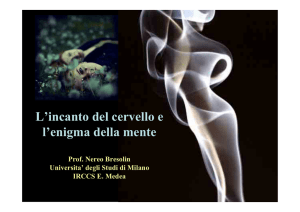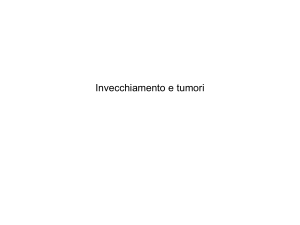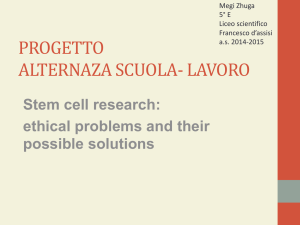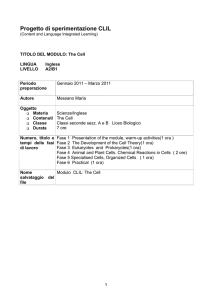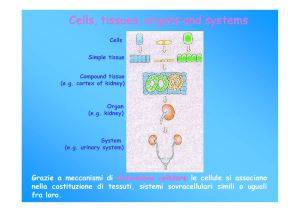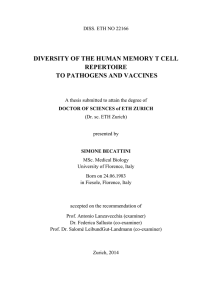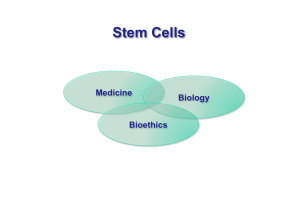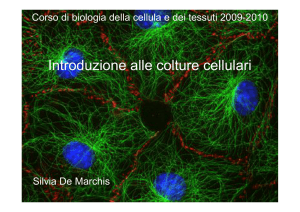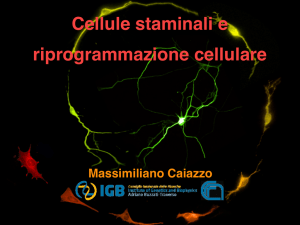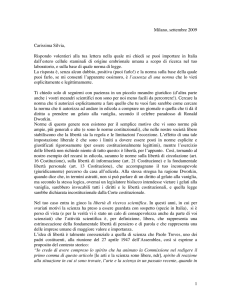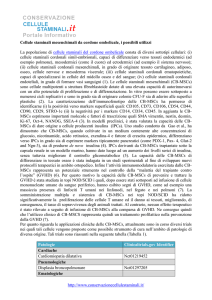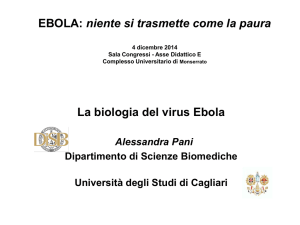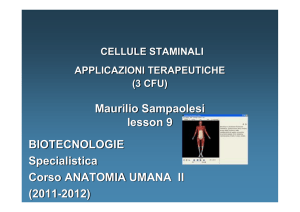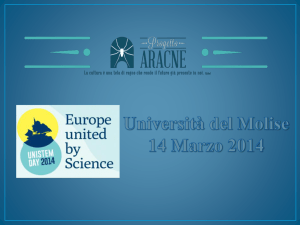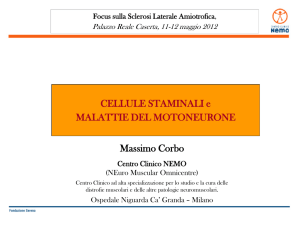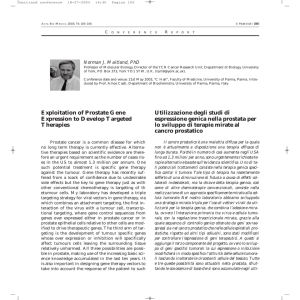26) Da fare SVILUPPO_ifferenziam.pptx
annuncio pubblicitario
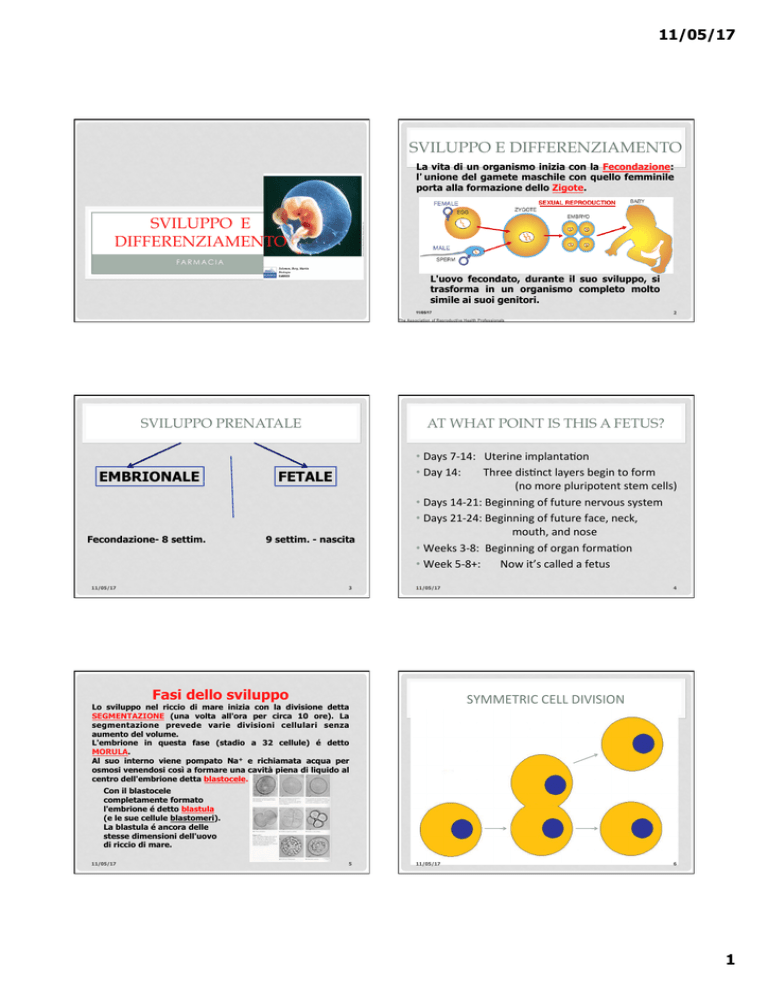
11/05/17 SVILUPPO E DIFFERENZIAMENTO La vita di un organismo inizia con la Fecondazione: l unione del gamete maschile con quello femminile porta alla formazione dello Zigote. SVILUPPO E DIFFERENZIAMENTO FA R M A C I A L'uovo fecondato, durante il suo sviluppo, si trasforma in un organismo completo molto simile ai suoi genitori. 2 11/05/17 The Association of Reproductive Health Professionals SVILUPPO PRENATALE EMBRIONALE Fecondazione- 8 settim. AT WHAT POINT IS THIS A FETUS? FETALE 9 settim. - nascita 11/05/17 3 • Days7-14:Uterineimplanta4on • Day14:Threedis4nctlayersbegintoform (nomorepluripotentstemcells) • Days14-21:Beginningoffuturenervoussystem • Days21-24:Beginningoffutureface,neck, mouth,andnose • Weeks3-8:Beginningoforganforma4on • Week5-8+:Nowit’scalledafetus 11/05/17 Fasi dello sviluppo 4 SYMMETRICCELLDIVISION Lo sviluppo nel riccio di mare inizia con la divisione detta SEGMENTAZIONE (una volta all'ora per circa 10 ore). La segmentazione prevede varie divisioni cellulari senza aumento del volume. L'embrione in questa fase (stadio a 32 cellule) é detto MORULA. Al suo interno viene pompato Na+ e richiamata acqua per osmosi venendosi così a formare una cavità piena di liquido al centro dell'embrione detta blastocele. Con il blastocele completamente formato l'embrione é detto blastula (e le sue cellule blastomeri). La blastula é ancora delle stesse dimensioni dell'uovo di riccio di mare. 11/05/17 5 11/05/17 6 1 11/05/17 La formazione della blastula è seguita dal p r o c e s s o d i gastrulazione. Essa i n i z i a c o n l a formazione del blastoporo il cui strato di cellule dirigendosi verso l'interno forma una nuova cavità l'archenteron che darà origine al canale digerente, mentre il blastoporo diventerà l'ano. 11/05/17 7 11/05/17 8 Lo SVILUPPO passa attraverso 3 FASI principali: ASYMMETRICCELLDIVISION la CRESCITA (divisioni cellulari), DIFFERENZIAMENTO e la MORFOGENESI. il 1. Self-renews 2. Differen4ates Progenitor cell 11/05/17 Stem cell Stem cell 9 Day 1 Fertilized egg 11/05/17 Day 2 2-cell embryo Day 11-14 Tissue Differentiation Day 3-4 Multi-cell embryo Day 5-6 Blastocyst 10 Impianto SEGMENTAZIONE Early division of zygote into multiple cells without increase in size, partitions contents Morula embedding of blastocyst into uterine lining begins at day 7 solid ball of cells Blastocyst - with blastocoele cavity Trophoblast - outer layer of cells Inner cell mass - will form embryo Trophoblast forms syncytial trophoblasterodes into endometrium Cellular trophoblast - carries nutrients to inner cell mass Zygote Lacunae and primary villi formed by trophoblast All of these form placental tissues Blastocyst with blastocoele cavity 11/05/17 12 2 11/05/17 Placentazione Placenta Development of placenta from edges of blastocyst Placenta = organ that forms from the chorion and the endometrium and allow the embryo/fetus to exchange nutrients and waste. Chorionic villi provide surface area for exchange Nutrient and gas exchange happens without actual blood exchange Umbilical cord - contains two umbilical arteries and one umbilical vein Oxygen & nutrients diffuse from the mother s blood vessels into the baby s blood vessels Wastes diffuse from the baby s blood vessels into the mother s blood vessels SACCO AMNIOTICO Placenta two arteries and a vein Connects the fetus to the placenta Contains fluid (amniotic fluid) that protects fetus by giving it a stable environment and absorbing shock GASTRULAZIONE I movimenti dello strato di cellule durante la gastrulazione porta alla formazione di tre strati di tessuto embrionale, TRE FOGLIETTI EMBRIONALI: - ECTODERMA - MESODERMA - ENDODERMA 11/05/17 17 11/05/17 18 3 11/05/17 DIFFERENZIAMENTO CELLULARE Lo zigote è una cellula TOTIPOTENTE: darà origine a tutte le altre cellule di un organismo pluricellulare. Durante lo sviluppo vengono generati dall uovo fecondato diversi tipi di cellule (es. cellule epiteliali, cellule muscolari etc.). Il patrimonio genetico delle cellule è lo stesso: EQUIVALENZA DEL GENOMA o EQUIVALENZA NUCLEARE. Esistono poche eccezioni a questo principio come riarrangiamenti genomici (es. anticorpi) e amplificazioni geniche. 11/05/17 19 11/05/17 20 The Nobel Prize in Physiology or Medicine 2012 Sir John B. Gurdon, Shinya Yamanaka TOTIPOTENZA NUCLEARE The Nobel Prize in Physiology or Medicine 2012 was awarded jointly to Sir John B. Gurdon and Shinya Yamanaka " For The Discovery That Mature Cells Can Be Reprogrammed To Become Pluripotent" The Developmental Capacity of Nuclei taken from Intestinal Epithelium Cells of Feeding Tadpoles by J. B. GURDON 1 From the Embryology Laboratory, Department of Zoology, Oxford John B. Gurdon, 1962 WITH ONE PLATE The developmental capacity of nuclei taken from intestinal epithelium cells of feeding tadpoles. Journal of Embryology and Experimental Morphology (1962) 10:622-640. 11/05/17 21 INTRODUCTION http://www.nobelprize.org/nobel_prizes/medicine/laureates/2012/ A N important problem in embryology is whether the differentiation of cells 11/05/17 depends upon a stable restriction of the genetic information contained in their nuclei. The technique of nuclear transplantation has shown to what extent the nuclei of differentiating cells can promote the formation of different cell types (e.g. King & Briggs, 1956; Gurdon, 1960c). Yet no experiments have so far been published on the transplantation of nuclei from fully differentiated normal cells. This is partly because it is difficult to obtain meaningful results from such experiments. The small amount of cytoplasm in differentiated cells renders their nuclei susceptible to damage through exposure to the saline medium, and this makes it difficult to assess the significance of the abnormalities resulting from their transplantation. It is, however, very desirable to know the developmental capacity of such nuclei, since any nuclear changes which are necessarily involved in cellular differentiation must have already taken place in cells of this kind. The experiments described below are some attempts to transplant nuclei from fully differentiated cells. Many of these nuclei gave abnormal results after transplantation, and several different kinds of experiments have been carried out to determine the cause and significance of these abnormalities. The donor cells used for these experiments were intestinal epithelium cells of feeding tadpoles. This is the final stage of differentiation of many of the endoderm cells whose nuclei have already been studied by means of nuclear transplantation experiments in Xenopus. The results to be described here may therefore be regarded as an extension of those previously obtained from differentiating endoderm cells (Gurdon, 1960c). 22 MATERIAL AND METHODS CLONAZIONE DEI MAMMIFERI The animals used for these experiments belong to the subspecies Xenopus laevis laevis. The transplantation technique has been carried out as described previously (Elsdale et al., 1960), except that the donor tissue was exposed to 1 IJ. Embryo!, exp. Morph., Vol. 10, Part 4, pp. 622-40 December 1962] CROMATINA E DIFFERENZIAMENTO Dolly è stata sottoposta ad eutanasia all età di 6 anni perché aveva un tumore al polmone di origine virale. Aveva sviluppato artrite a 5 anni, probabile invecchiamento precoce. 11/05/17 Author's Address: Department of Zoology, Parks Road, Oxford, U.K. 23 11/05/17 24 4 11/05/17 METHYLATION REPROGRAMMING DURING MOUSE DEVELOPMENT. LA METILAZIONE È REGOLATA DURANTE LO SVILUPPO per ristabilire l imprinting nelle nuove cellule somatiche necessita l intervento di Dnmt3a e Dnmt3b red, m; blue, p ovocita embrioni Santos F , and Dean W Reproduction 2004;127:643-651 11/05/17 25 © 2004 Society for Reproduction and Fertility Per ogni embrione che si forma, l'imprinting viene azzerato e ristabilito, poiché subito dopo la fecondazione l intero genoma subisce un onda di demetilazione (ad opera di enzimi Demetilasi) L espressione di una piccola minoranza di geni, nei mammiferi, è determinata dalla propria origine parentale 11/05/17 27 IMPRINTING Per molti geni ereditiamo due copie, uno materno e uno paterno. Con l’imprinting solo una copia funziona (es. Inattivazione del cromosoma “X”). Normalmente l’imprinting avviene attraverso la metilazione del DNA durante la formazione dei gameti. 11/05/17 TESSUTO-SPECIFICO somatiche Ø si trasmette stabilmente per mitosi Ø gameti • Metiltrasferasi di mantenimento (Dnmt1) • Metiltrasferasi de novo (Dnmt3a e Dnmt3b) Ø cellule SVILUPPO-SPECIFICO Ø si instaura ex novo dopo meiosi 29 5 11/05/17 L IMPRINTING DURANTE LA GAMETOGENESI La metiltrasferasi de novo rinnova l imprinting ad ogni generazione : quindi, durante la gametogenesi, l'imprinting viene cancellato e ripristinato successivamente in base al sesso del soggetto Il gene segue un imprinting paterno Femmina entrambi i geni che trasmette alla progenie NON saranno imprinted (entrambe le copie saranno attive) Maschio saranno imprinted entrambe le copie (entrambe NON funzionanti) L IMPRINTING DURANTE LA DIVISIONE CELLULARE LA METILTRASFERASI DI MANTENIMENTO AGISCE DA STAMPO SUL FILAMENTO PARENTALE, PER LA METILAZIONE DEL NUOVO FILAMENTO. TALE SCHEMA VIENE EREDITATO ALLE CELLULE FIGLIE, ASSICURANDO IN TAL MODO CHE NEI TESSUTI DIFFERENZIATI SIA MANTENUTO IL PROFILO DI ESPRESSIONE GENICA APPROPRIATO ANCHE NEL CASO IN CUI LE CELLULE VENGANO SOSTITUITE O NE SIANO AGGIUNTE DI NUOVE Attualmente è stato provato che circa 60 geni umani sono soggetti ad ü imprinting. La mancanza di un imprinting genetico corretto che coinvolge i geni del cromosoma 15 causa Nell uomo la maggioranza dei geni ü soggetti a imprinting è autosomica. Molti dei geni umani soggetti a imprinting si trovano raggruppati in due localizzazioni principali nel genoma: una zona di circa 1 Mbp si trova sul cromosoma 11 SINDROME DI ANGELMAN mentre un secondo raggruppamento, esteso per 2,3 Mbp, si trova sul cromosoma 15. ü Alcuni di questi geni sono coinvolti nella regolazione della crescita del feto: i geni paterni partecipano a rimuovere i nutrienti in modo aggressivo dal corpo della madre, per cui sono espressi nel trofoblasto e nelle membrane extraembrionarie; i geni materni si oppongono all effetto dei geni paterni, "proteggono la madre" provocando l accumulo di nutrienti per le cellule discendenti, e sono espressi soprattutto nell embrione. Cromosoma materno SINDROME DI PRADER-WILLI Cromosoma paterno Due sindromi complesse che influenzano lo stato ormonale, il metabolismo e la capacità di movimento. LA GENETICA DELLE MALATTIE DI E DI PRADER-WILLI SYNDROME Le due malattie sono di solito causate da una microdelezione che colpisce il braccio lungo del cromosoma 15 ma, mentre nella PWS il cromosoma colpito è quello di origine paterna, nella AS è quello di origine materna. Il fatto che le due malattie siano clinicamente molto diverse è imputabile al fatto che i geni presenti in quella stes-sa regione genomica sono espressi diversamente nei cromosomi ereditati dall uno o dall altro genitore. Mentre la AS è causata dalla mancata espressione del solo gene UBE3A, la PWS è causata dalla mancata espressione di più geni. 11/05/17 36 6 11/05/17 Delezioni di certe regioni cromosomiche causano un fenotipo differente se presenti sul cromosoma paterno o materno. ANGELMAN SYNDROME Sindrome di Angelman Cromosoma materno Cromosom a paterno Sindrome di Prader-Willi 11/05/17 37 Il gene per il fattore di crescita simile all insulina 2 (Igf-2) è necessario per la crescita prenatale (Hs11p15.5). Topi che non lo esprimono hanno alla nascita metà delle dimensioni di un topo normale. Soltanto la copia paterna di Igf-2 è trascritta ed ha importanza per il fenotipo. • Topi con un gene Igf-2 mutato di derivazione paterna sono nani • Topi con un gene Igf-2 difettoso di origine materna sono normali The mouse Igf2 gene produces a growth factor, and homozygous mutants are dwarf mice. 11/05/17 STEM CELL – DEFINITION KINDS OF STEM CELLS • A cell that has the ability to continuously divide and differentiate (develop) into various other kind(s) of cells/tissues 11/05/17 40 41 Stem cell type Description Examples Cells from early (1-3 days) embryos Totipotent Each cell can develop into a new individual Pluripotent Some cells of Cells can form any (over blastocyst (5 to 14 200) cell types days) Multipotent Cells differentiated, but can form a number of other tissues 11/05/17 Fetal tissue, cord blood, and adult stem cells 42 7 11/05/17 EMBRYONIC STEM CELLS IN THE DISH: WHAT DO CULTURED ES CELLS LOOK LIKE? 43 11/05/17 11/05/17 44 Updated February 2007 Regulations in EU Member States regarding hES1 cell research AT Allowing procurement of hES cells from super-numary embryos by law BE BG CY X CZ DE X DK Specific legislation for human embryo research incl. supernumerary embryos but without specific reference to hES cells Allowing creation of human embryos for procurement of hES cells by law Prohibiting creation of human embryo for research purpose and for procurement of hES cells by law or by ratification of the Convention of the Council of Europe on Human rights and Biomedicine signed in Oviedo on 4 April 1997 1) EL ES FI FR X X X X X Prohibiting procurement of hES cells from human embryos but allowing importation of hES cell lines No specific legislation regarding hES cell research EE X HU IE IT* X LU LV MT NL PL X X PT RO X SE SI SK X X X X LT X X X X X X X X X X X X X X X X X UK X X X X X X X X X X X X X X X X X X X hES cells = human Embryonic Stem cells *IT has no law regarding the importation & IT scientists are working on imported hES cell lines COUNTRY CODE KEY: AT : Austria BE : Belgium BG: Bulgaria CY : Cyprus CZ : Czech Republic 11/05/17 DE : Germany DK : Denmark EE : Estonia EL : Greece ES : Spain FI : Finland FR : France HU : Hungary IE : Ireland IT : Italy LT : Lithuania LU : Luxembourg LV : Latvia MT : Malta NL : Netherlands PL : Poland PT : Portugal RO: Romania SE : Sweden SI : Slovenia SK : Slovakia UK : United Kingdom http://www.ncbi.nlm.nih.gov/pubmed/ 45 11/05/17 46 (Embryonic stem cells) ES cells have two important properties. The fist one is their nearly infinite proliferation. We can expand the numbers of ES cells as much as we want. The other important property is pluripotency, the ability to differentiate into nearly all types of somatic cells that exist in body, such as muscle cells and nerve cells. We found that NAT1 is indispensable for the pluripotency of mouse ES cells. When we disrupted the NAT1 function, ES cells became unable to differentiate. Because of this unexpected result, my research interest shifted from cancer to stem cells. Shinya Yamanaka 11/05/17 47 11/05/17 48 8 11/05/17 Shinya Yamanaka Department of Stem Cell Biology, Institute for Frontier Medical Sciences, Kyoto University, Kyoto 606-8507, Japan Shinya Yamanaka 11/05/17 49 11/05/17 50 51 11/05/17 52 Shinya Yamanaka 11/05/17 LINEAGES DERIVED FROM HUMAN IPS CELLS Takahashi K et al. Cell 2007, 131: 861-872 11/05/17 53 11/05/17 54 9 11/05/17 TIME COURSE OF HUMAN IPS COLONY FORMATION STEM CELL MARKERS SSEA-4 Timing: Infection to colony formation (p0): 18-25 days p0 to p3: 10-12 days for each passage; 50-60 days total p3 to p4: 7 days 11/05/17 55 55 11/05/17 SSEA-4 56 CELLULE STAMINALI Non tutte le cellule si differenziano. Alcune rimangono indifferenziate e capaci di generare altri tipi di cellule: le cellule staminali. La pelle è costituita da un insieme di tessuti. Ognuno ha un proprio ritmo di rinnovamento. 11/05/17 57 11/05/17 11/05/17 59 11/05/17 58 Shinya Yamanaka 60 10 11/05/17 MEDICINA RIGENERATIVA LEMBO DI EPITELIO CORNEALE COLTIVATO IN VITRO 2007: Comunità Europea ha stabilito che i prodotti per terapie avanzate basati su colture cellulari sono classificati come medicinali, e pertanto regolamentati dall’European Medicines Agency (EMA) e devono essere prodotti secondo le stesse norme GMP (Good Manufacturing Practices) già adottate dall’industria farmaceutica. 11/05/17 • Cellule staminali limbo-corneali per la rigenerazione della cornea in pazienti con deficit di cellule staminali limbari dovuto a severe ustioni termiche o chimiche della superficie oculare • Colture di cellule staminali epidermiche sono per la terapia salva-vita di pazienti con ustioni estese 61 STEM CELLS FOR DRUG DELIVERY MORE FOCUSED DELIVERY, FEWER SIDE AFFECTS Day 0 Day 7 Day 14 11/05/17 http://www.holostem.com/Terapie_avanzate.html 62 PROS AND CONS TO IPS CELL TECHNOLOGY • Pros: • Cellswouldbegene4callyiden4caltopa4entordonorof skincells(noimmunerejec4on!) • Donotneedtouseanembryo NSCs injected (no tumor) • Cons: • Cellswoulds4llhavegene4cdefects • Oneofthepluripotencygenesisacancergene • Virusesmightinsertgenesinplaceswedon twantthem (causingmuta4ons) NSCs injected (tumor) Shah et al. Dev Neurosci 2004 11/05/17 63 11/05/17 64 11
